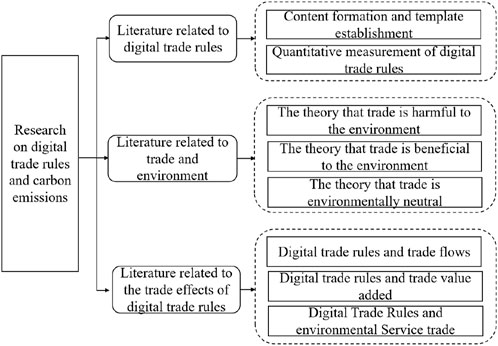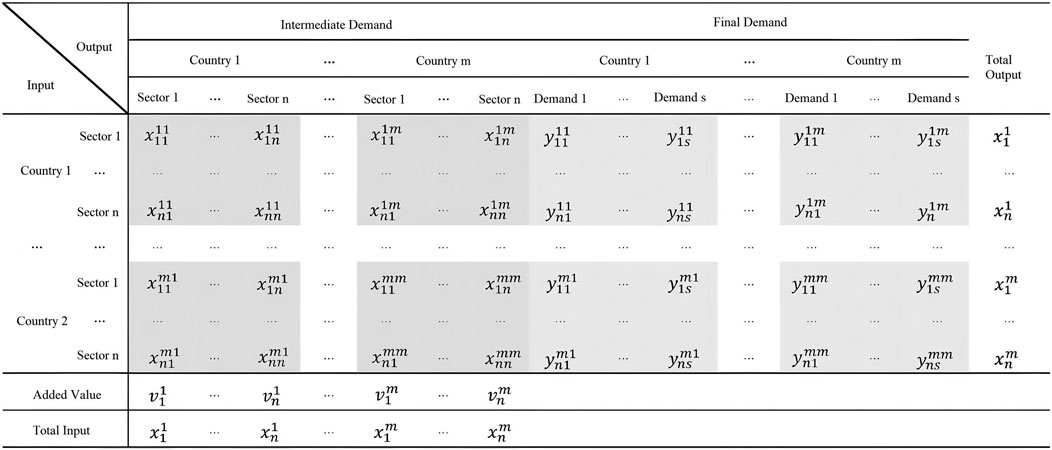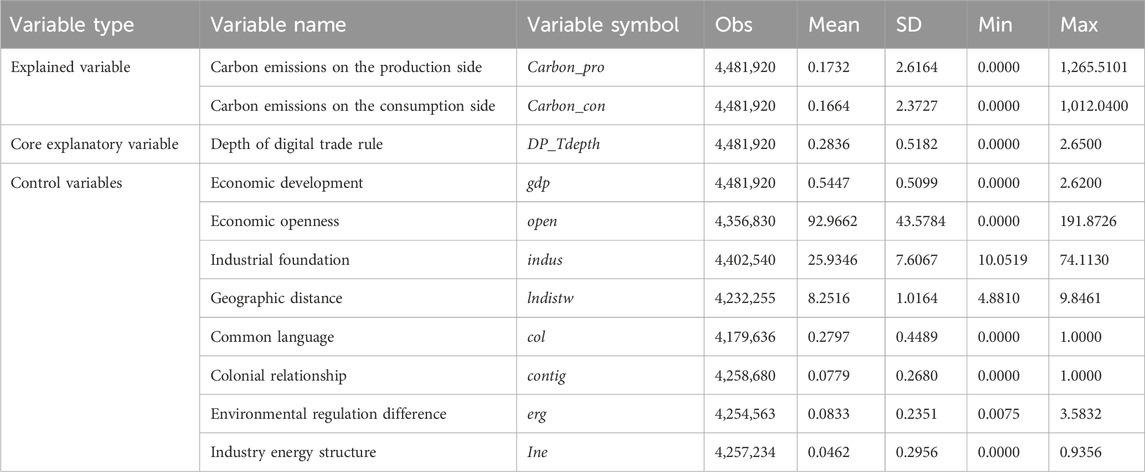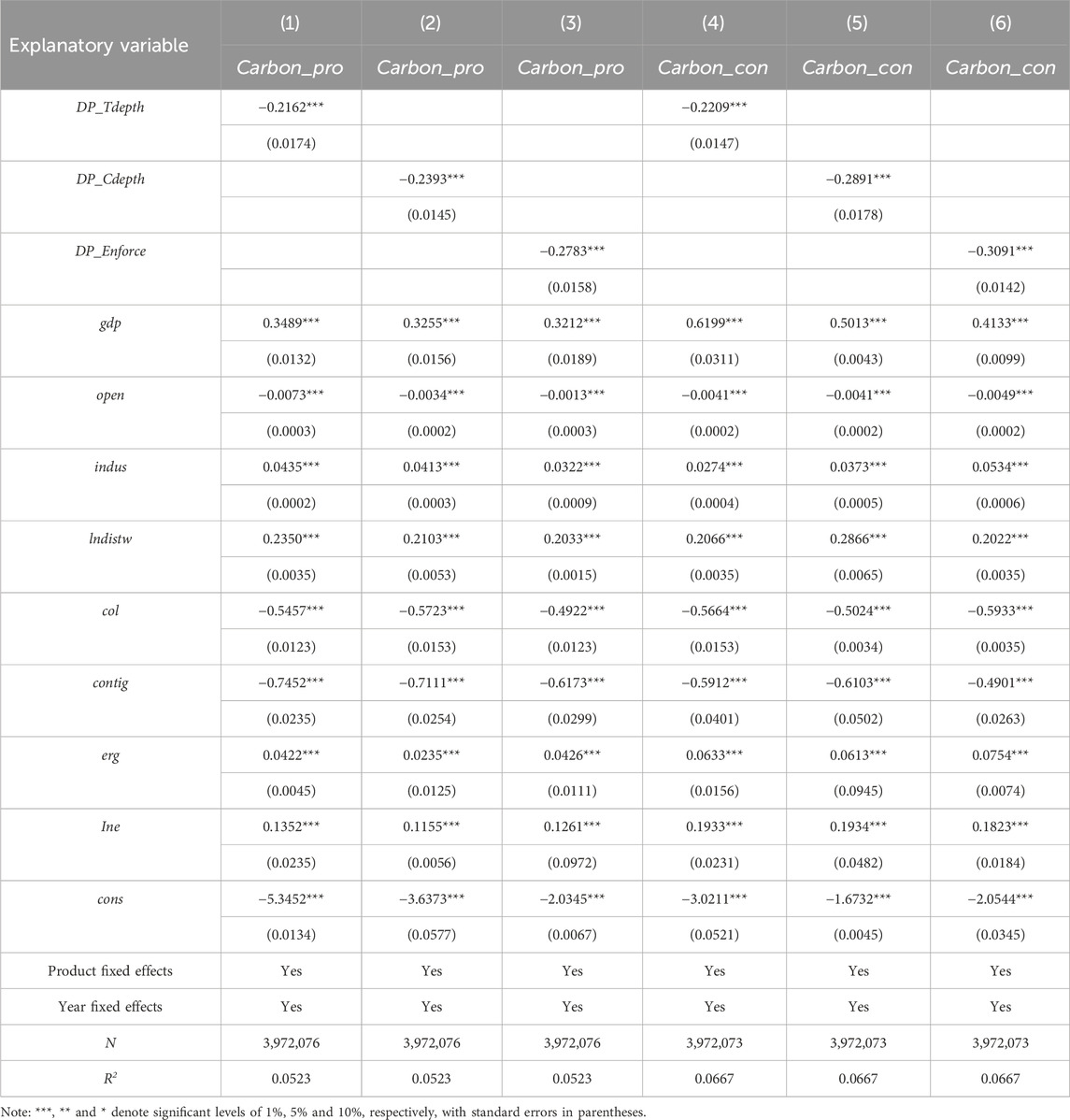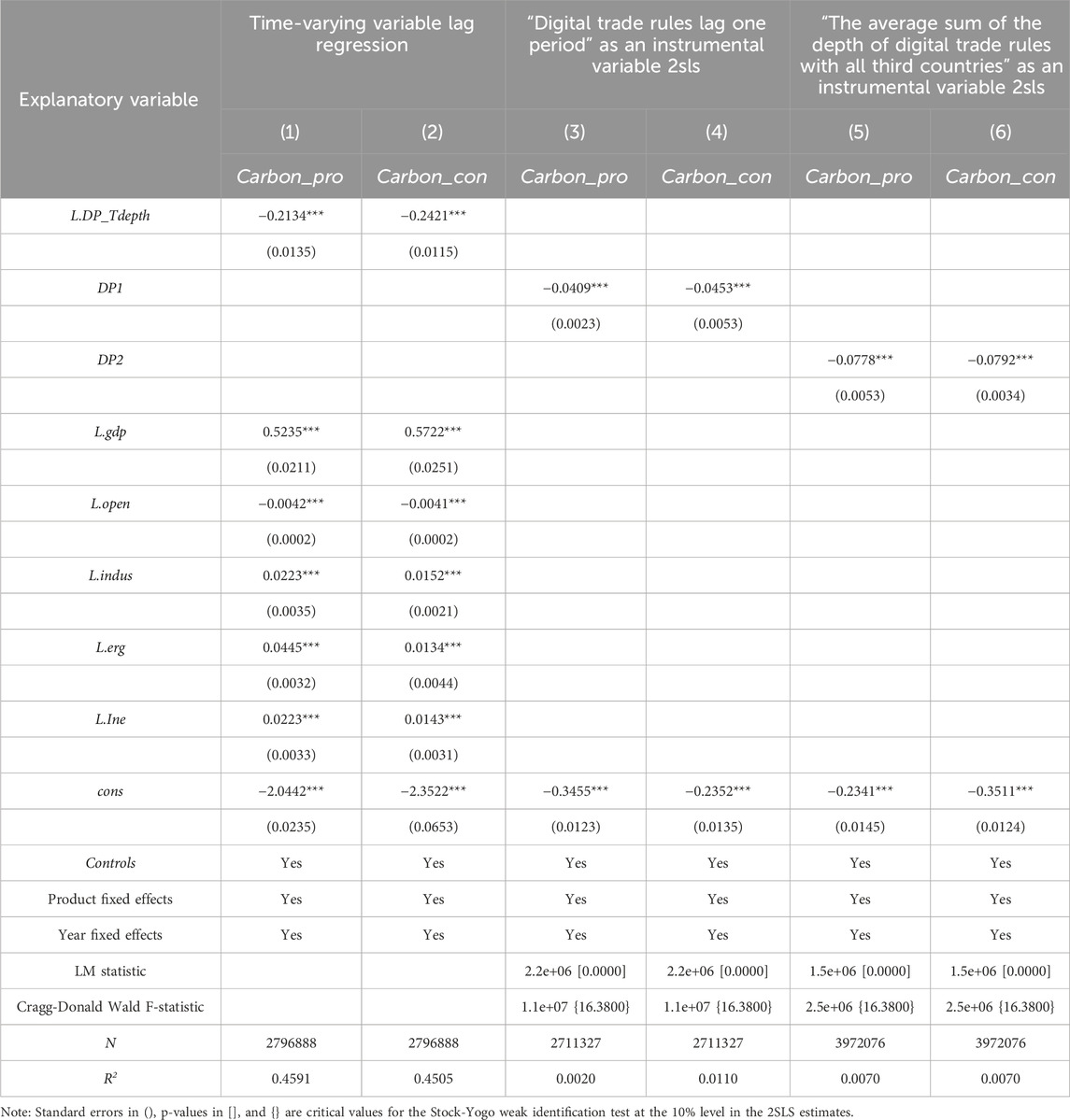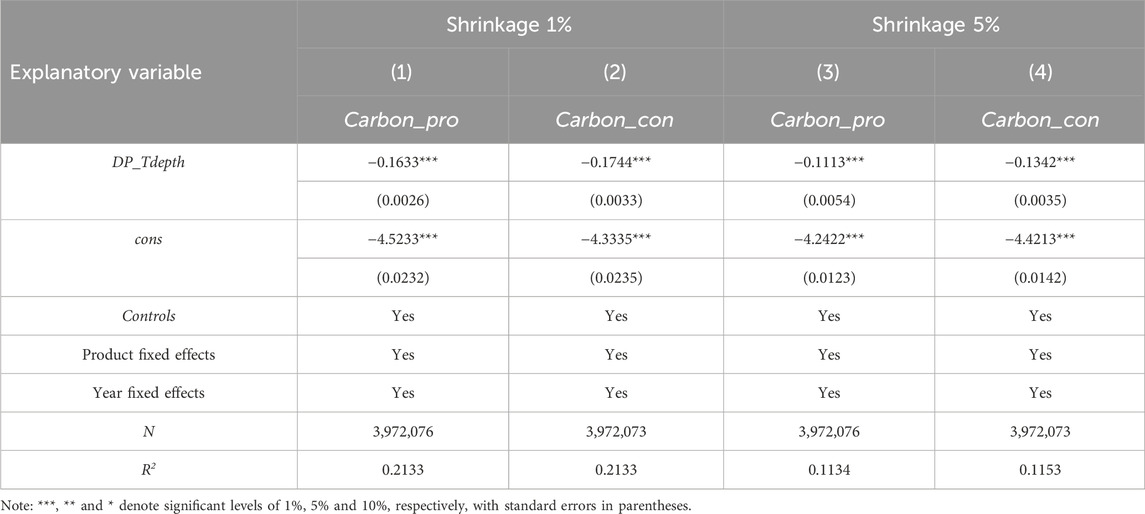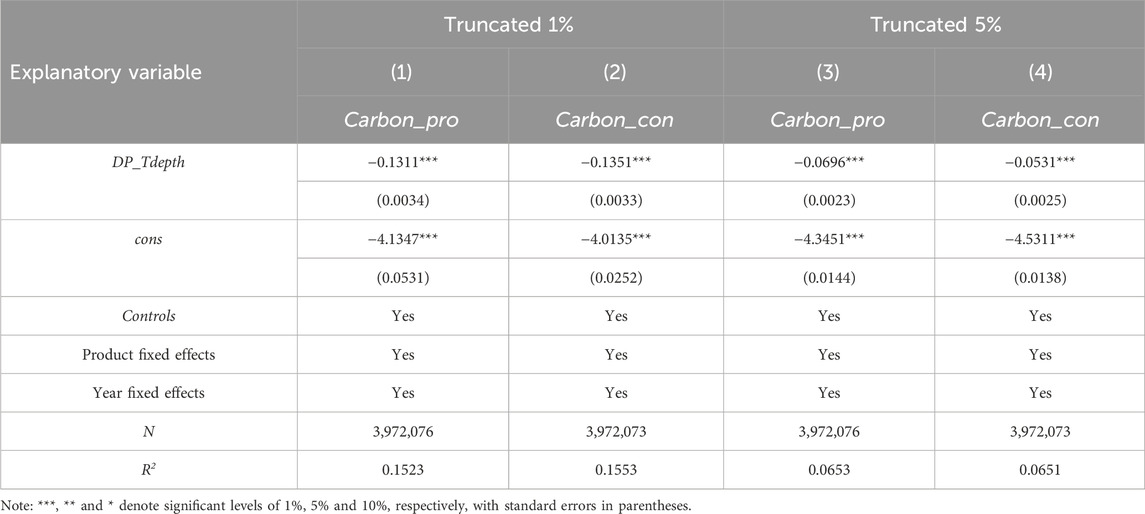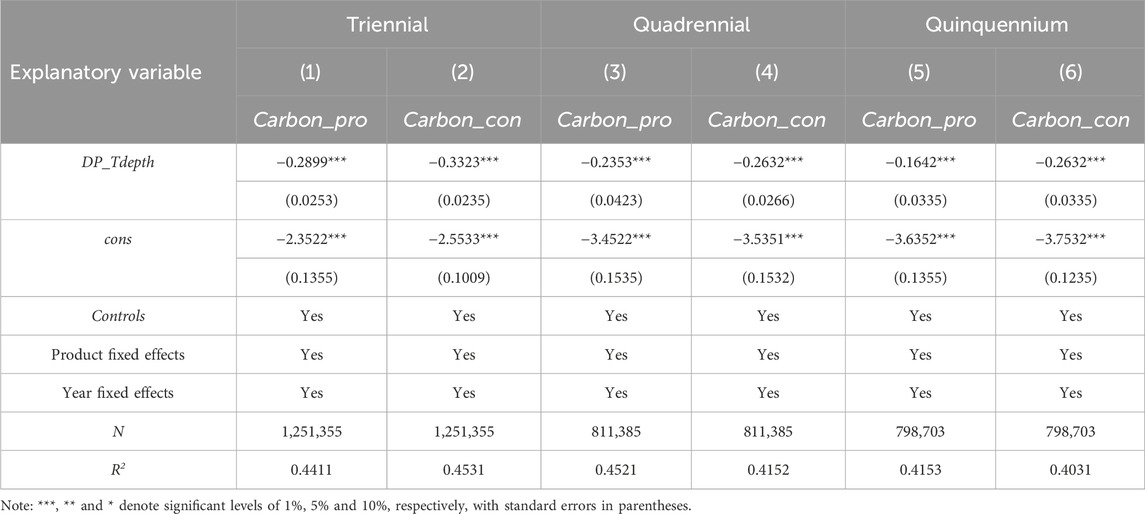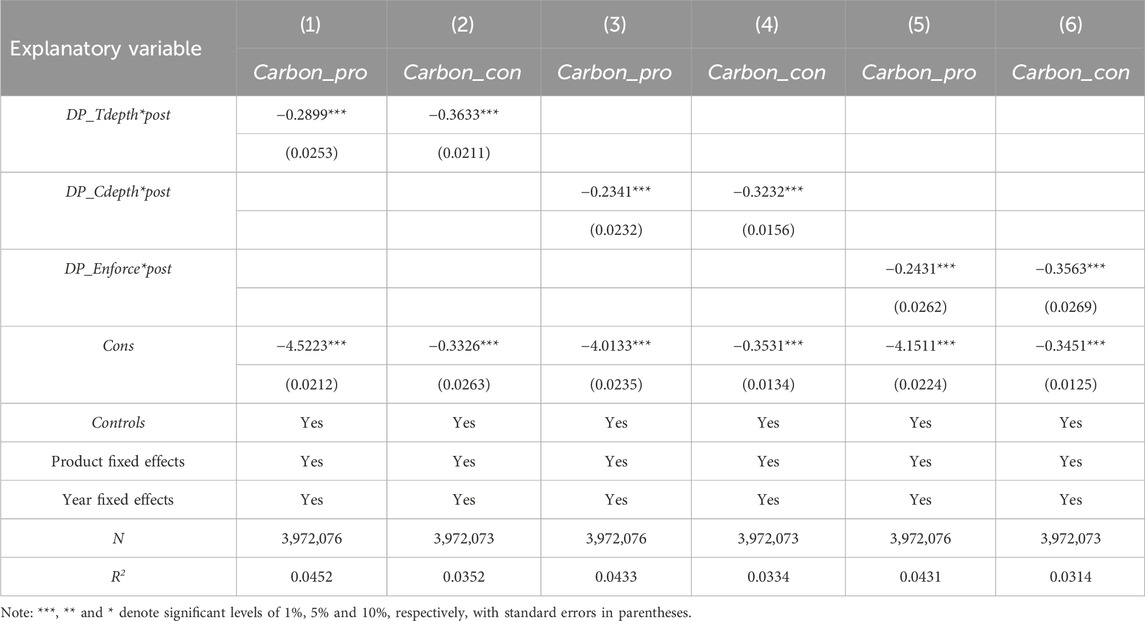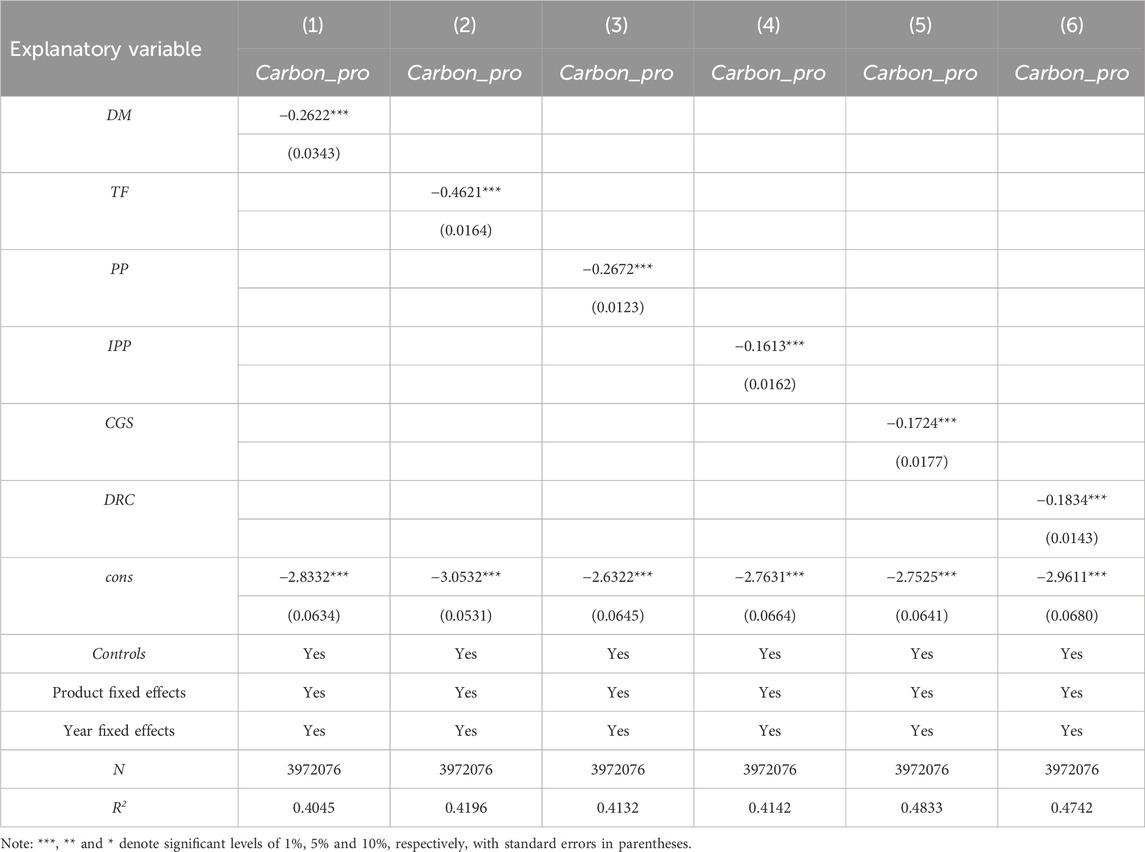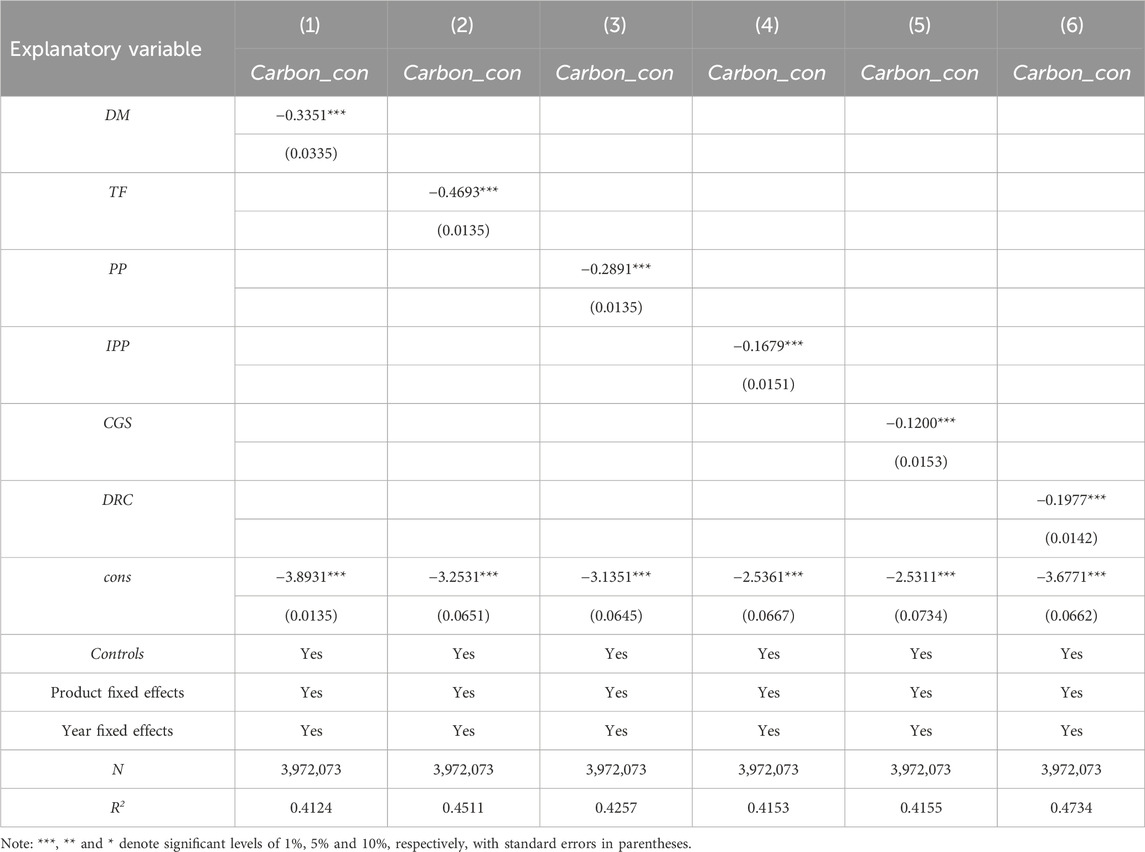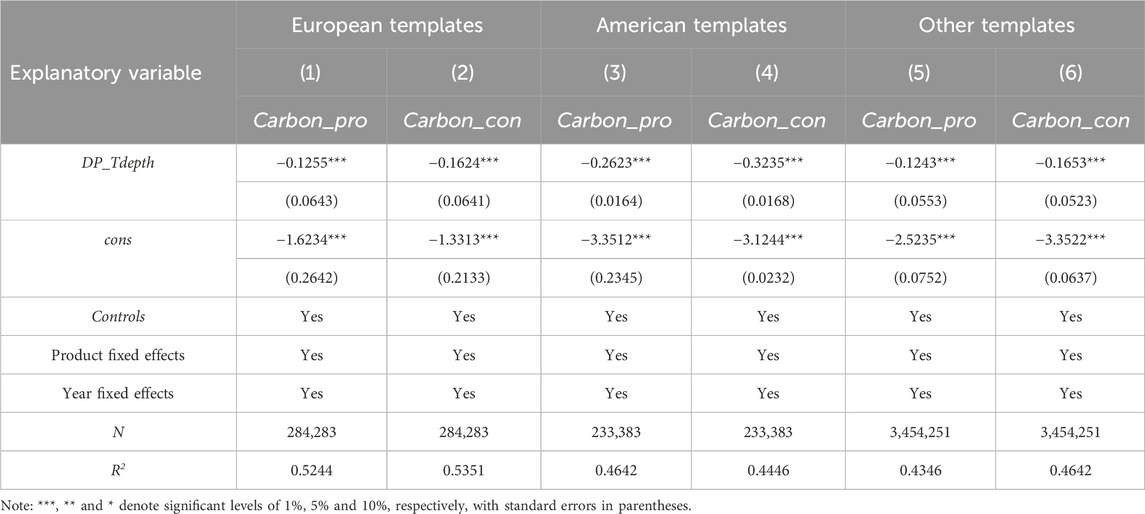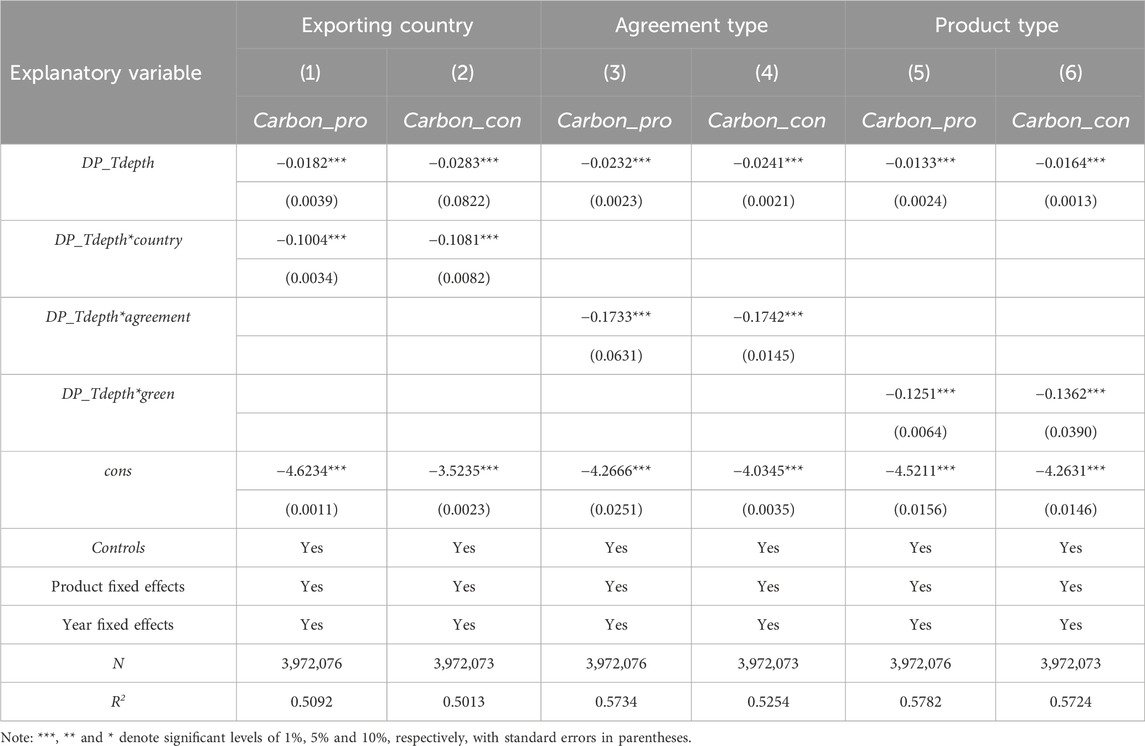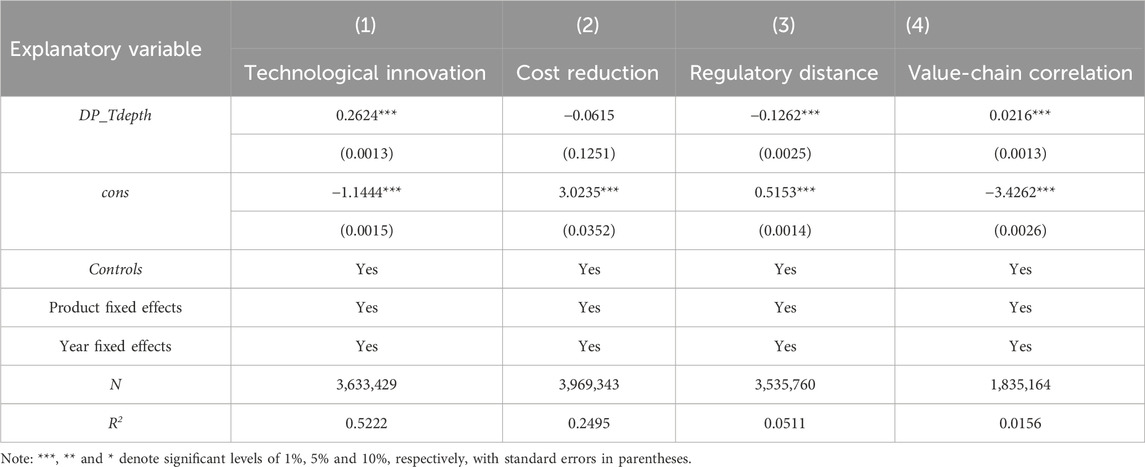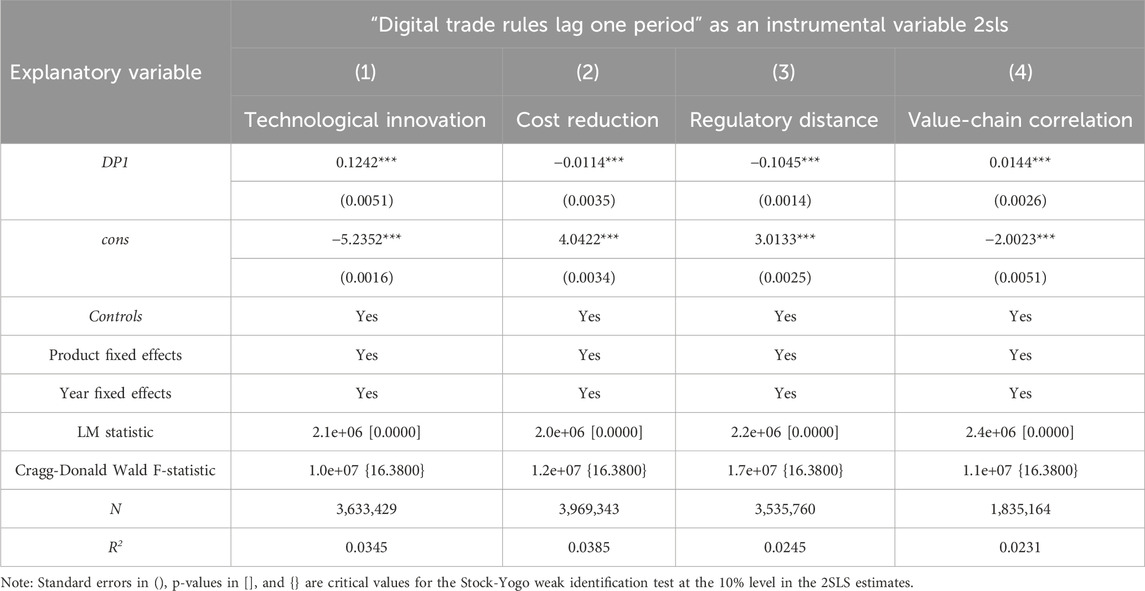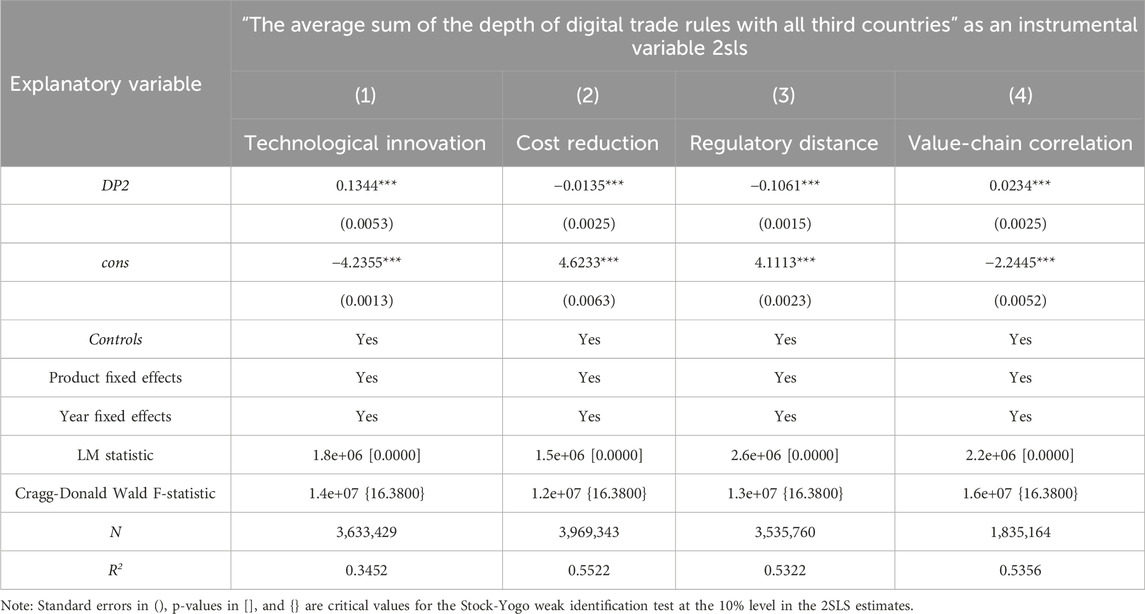- 1School of Economics, Yunnan University of Finance and Economics, Kunming, China
- 2School of Economics and Management, Shaanxi University of Science and Technology, Xi’an, China
Introduction: The synergistic development of digitalisation and environmental protection is an important issue in the context of global economic development. The core issue that needs to be addressed is whether digital trade rules can reduce the export embodied carbon emissions and what the specific mechanisms are.
Method: Using regional trade agreements (RTA) and bilateral trade data signed and implemented by 137economies from 2001 to2021, this paper quantifies the depth of digital trade rules from three aspects: total depth, core depth and enforce depth, based on the classification of digital trade rules in the TAPED database. Subsequently, by using the extended structural gravity model and adopting the PPML estimation method, the influence effect and mechanism of digital trade rules on the export-embodied carbon emissions at the production and consumption sides in RTA were explored.
Results: (1) The deepening of digital trade rules can significantly reduce the intensity of implied carbon emissions from exports at both the production and consumption sides; the effect on implied carbon emissions at the consumption side is greater than at the production side. (2) Mechanism analysis shows that the effects of technological innovation, cost reduction, shortening regulatory distances and bilateral value chain correlation are important mechanisms in the impact of digital trade rules on export embodied carbon emission intensity. (3) Heterogeneity analysis shows that trade promotion provisions have the strongest effect on export-related carbon emissions, followed by data management provisions. Intellectual property protection provisions have the weakest effect. Bilateral agreements, US templates, exports to developed countries and green products in digital trade rules have a greater inhibitory effect on carbon emissions. The study proposes policy recommendations to promote the adoption of high-level digital trade rules and reduce carbon emissions from trade.
1 Introduction
The combined development of trade liberalisation and environmental protection is a vital issue for achieving sustainable development in today’s global context. Since joining the World Trade Organization (WTO) more than 2 decades ago, China has been continuously liberalising its trade, resulting in significant reductions in trade costs and a consequent increase in the total volume of foreign trade. However, traditional trade is also associated with a number of challenges, including ecological damage, increased pollution, excessive carbon emissions and global warming, while at the same time promoting global economic growth. As the global population grows and the global economy expands, so too do global carbon dioxide emissions, which have increased cumulatively by 60.77% from 1990 to 20191. Furthermore, the repercussions of extreme weather, attributable to climate warming, sea level rise, and reduced food production, among other challenges, pose a grave threat to human security. There is now a global consensus that urgent action is required to reduce energy waste, pollutants, and carbon emissions. Green trade is distinct from traditional trade in that it considers environmental factors. It is essential for promoting sustainable economic development. In 2021, the Green International Trade: The Way Forward report issued by the United Nations Environment Programme used the term green trade multiple times, proposing to build an environment and trade 2.0 agenda by enhancing trade-related environmental policies and advancing environmental regulations in trade policies and agreements, promoting environment and trade-related cooperation and related approaches.
The contemporary trend of international trade, driven by the scientific, technological and industrial revolution, is shifting from “value chain trade” to “digital trade”. In the current era of digital trade, the majority of countries are in favour of the establishment of digital trade rules, in stark contrast to the lagging development under the WTO framework. The rise of free trade agreements has resulted in the global management of digital trade shifting to bilateral and regional forms (Janow and Mavroidis, 2019). According to WTO statistics, 116 regional trade agreements (RTAs) of 341 RTAs that have been signed and entered into force around the world included special chapters on e-commerce and accounted for 34.0% of the total number of agreements as of December 20222. The WTO predicts that digital technology will drive the growth of global trade volume by 1.8%–2% annually by 20303, and the cooperation mechanism based on RTAs’ digital trade rules is a key platform for connecting global economic openness and cooperation.
The “Proposal of the Central Committee of the Communist Party of China on Formulating the 14th Five-Year Plan for National Economic and Social Development and Long-Range Objectives Through the Year 2035”4 points out that it is necessary to actively participate in the formulation of international rules and standards in the digital field, while also emphasising the incorporation of environmental goals into the consideration of international digital trade rule negotiations. In contrast to traditional trade, digital trade has the potential to be more environmentally friendly. Digital technology has transformed traditional trade patterns, helping to improve energy efficiency and reduce dependence on high-energy-consuming industries to advance pollution reduction (Mesagan et al., 2022; Li and Meng, 2024). Driven by the growth in digital trade, companies now have new opportunities to upgrade from traditional industries, optimise their industrial configurations, and reduce environmental impacts from export activities (Ma et al., 2019). Digital trade has been shown to have a significant impact on traditional trade, leading to the transformation of trade forms, objects and patterns. It has been demonstrated that digital trade has the capacity to generate new industries, business forms and models, and can also generate scale, scope and demonstration effects. Furthermore, studies have identified a positive influence on reducing pollutants and carbon emissions (Oh and Park, 2016; Liu et al., 2024). Digital trade rules are an integral part of the RTA rules system, extending from a single e-commerce chapter to investment, intellectual property (IP) rights, information technology, legal liability, dispute resolution, customs clearance facilitation and other considerations. The content of laws, policies and standards in these areas is continuously improved, updated and expanded, and the enforceability is constantly strengthened. Digital trade rules have effectively supplemented and replaced traditional trading systems, thereby promoting sustainable trade development. Digital trade rules improve supply chain efficiency and reduce carbon emissions by simplifying cross-border processes, cutting paperwork, and promoting green technology adoption, while real-time data monitoring supports more precise carbon emission management across global trade networks (Fan and Hossain, 2018; Haldar and Sethi, 2022). The question of whether digital trade rules can reduce export-embodied carbon emissions and bring environmental dividends is a pertinent one. What are the specific mechanisms involved? The answers to these questions are of considerable practical significance in promoting the recognition of digital trade rules and China’s green, low-carbon economy, as well as advancing the coordinated development of trade and environmental protection.
This paper utilises MRIO data from 137 major economies worldwide from 2001 to 2021 to empirically examine the effect and mechanism of deepening digital trade rules on export embodied carbon emissions. Firstly, this study innovates by focusing on the depth of digital trade rules, as opposed to previous studies which only consider the presence or absence of digital trade terms. The TAPED database was used to construct a more refined index system for the depth of digital trade rules, which was deconstructed into three dimensions for quantification. The terms that require clarification are “total depth”, “core depth” and “enforce depth”. This multi-dimensional measurement method can capture the binding force of different rule terms and their potential environmental impact differences more comprehensively and accurately. Secondly, this paper provides micro-mechanism support for the environmental effects of digital trade rules and offers empirical evidence for countries when negotiating and formulating “green” digital trade rules. This research makes an important contribution to the cross-disciplinary study on the economic and environmental effects of digital trade rules, deepening the theoretical understanding of the “green dividend” of digital trade. It also provides valuable academic support and policy references for promoting the coordinated development of the digital economy and the green economy on a global scale, and for addressing the challenges of climate change through international rule cooperation. The empirical findings on the emission reduction mechanisms and the heterogeneous results have also indicated the direction for policymakers to precisely design a trade rule system that promotes figures and reduces emissions.
2 Literature review
Three types of literature are related to this study including literature related to digital trade rules, literature related to trade and environment and literature related to the trade effects of digital trade rules (see Figure 1).
2.1 Literature related to digital trade rules
One approach concerns the formation of rules on digital trade and the establishment of templates, with the content and classification under RTA frameworks having focused primarily on cross-border data flow, trade facilitation, privacy protection, IP protection, network security and dispute settlement and cooperation. Digital trade rules have evolved from e-commerce in the WTO into separate chapters on digital trade that cover a wide range of content, including a variety of subject demands and complex digital trade rule governance (Burri and Polanco, 2020). Depending on the different stages of digital industry development in regional trade member countries, two main types of digital trade rules have emerged that are characterised as American and European templates. The American template pursues digital trade liberalisation (Qi et al., 2023), whereas the European template emphasises cultural traditions and privacy, with “audio-visual exception” and “privacy protection” as the main features (Zhou and Chen, 2020). The second strand of digital trade rules research has focused on the quantitative measurement of digital trade rules, with a predominant emphasis on the assessment of its depth and breadth. With regard to breadth measurement, scholars have taken divergent approaches. Some have employed the total number of e-commerce chapter clauses for measurement (Elsig and Klotz, 2021), while others have utilised the weighted summation method based on the frequency of digital trade rules (Mattoo et al., 2022). In terms of depth measurement, scholars have categorised the digital trade rule provisions and employed different measurement methods. Sun et al. (2022) divided digital trade rules provisions into the following categories: e-commerce provisions, data provisions in the services chapter, digital IP rights provisions and cross-border data flow provisions. This division was achieved using an index quantification method. Peng et al. (2023) measured the depth of digital trade provisions in RTAs by dividing them into market access provisions for digital trade, trade facilitation provisions, consumer protection provisions, and data-related provisions using the assignment method. Cui et al. (2024) quantified the depth of digital trade provisions in RTAs based on e-commerce terms, data terms in the services section, digital IP terms and data flow terms.
2.2 Literature related to trade and environment
Despite extensive research examining this relationship, a consensus remains elusive. Contemporary research on trade and the environment has identified three perspectives: “trade is harmful to the environment”, “trade is beneficial to the environment” and “trade is neutral to the environment”. The first is the theory of environmental degradation based on the “pollution paradise” hypothesis. Some researchers have argued that trade will harm the environment, supporting the pollution paradise hypothesis proposed by Copeland and Taylor (1994). The core issue under discussion is that, in order to circumvent the trade costs associated with stringent environmental protection standards, organisations from developed countries often outsource production of polluting products to developing countries, where costs are lower. Zhang (2020) study examined the correlation between intermediate goods trade and the environment. The study’s findings revealed that an increase in intermediate goods trade can lead to an escalation in production fragmentation and environmental pollution in developing countries. Ekesiobi et al. (2024) found that international trade and FDI reduce CO2 in the short run but positively affect long-run CO2, supporting the long-run pollution haven hypothesis. The second perspective is the theory of environmental improvement based on the “pollution halo” hypothesis. Some academics have argued that trade has a positive impact on the environment. Fisher-Vanden et al. (2004) contended that increased trade openness can facilitate the use of green and clean technologies, promote the import of low-carbon products and reduce environmental pollution. Ma and Wang (2021) found that, in comparison with developed countries, developing China can effectively reduce carbon emissions intensity by participating in international trade. Kim et al. (2019) examined the case of trade between North and South countries, demonstrating that trade activities between developing countries and southern countries reduced carbon dioxide emissions. The third perspective is the theory that trade has no inherent environmental impact. As Grossman and Krueger (1995) and Li and Qi (2011) have suggested, the impact of trade on the environment is contingent on economic development. In the initial stages of economic growth, trade activities can be detrimental to the environment; however, as economies develop, they can also contribute positively to environmental protection.
2.3 Literature related to the trade effects of digital trade rules
The majority of studies have focused on whether and how RTAs’ digital trade rules influence trade flow, added value and environmental services. For instance, Duval et al. (2018) analysed the influence of digital trade terms facilitation on trade costs and demonstrated that digital trade facilitation terms reduced trade costs. Das and Andriamananjara (2006) observed that digital trade rules have the potential to reduce restrictions on information flow by breaking through geographic borders, thereby enhancing knowledge spillover effects. Mattoo et al. (2022) found that extensive trade treaties generated more trade creation benefits, but that the effects of trade diversion depend on the terms of the treaties. Using an empirical model, Cui et al. (2024) concluded that digital trade rules increase exporting countries’ domestic value added. Sun et al. (2022) considered the relationship between digital trade rules and service trade export using empirical evidence and concluded that digital trade rules contribute to digital service trade significantly. Li and Meng (2024) examined the environmental benefits of digital trade rules, demonstrating that it reduced the implied carbon emissions intensity of contracting countries’ exports. Research has been conducted by several scholars on the subject of the impact of digital technology and digital trade on carbon emissions. For instance, Chaney (2014) holds that the establishment of digital trade platforms has broken through the limitations of geographical and cultural distances, reduced the costs of searching for trade information, marketing and market development, shaken off the high reliance on traditional logistics methods, and effectively reduced carbon emissions in the trade process. Bieser and Hilty (2018) hold that digital technology can achieve the effect of reducing carbon emissions by enhancing production efficiency.
2.4 Literature review
To summarise, there has been a considerable amount of research on digital trade rules; however, some limitations remain. Firstly, the previous research has primarily focused on the overall trade effect of digital trade rules. While the majority of studies have explored its impact on services trade or export added value, the research has not yet delved into the expanding green trade sector and has rarely examined export-embodied carbon emissions. Secondly, while some studies have examined the influence of digital trade rules on green trade, there has been limited research into the impact of RTAs’ heterogeneous provisions on green trade, or into the mediating mechanisms by which digital trade rules affect green trade. Furthermore, the majority of studies have been from the country or industry perspective, rather than the product level.
Accordingly, the present study utilised the University of Lucerne’s Trade Agreement Provisions on Electronic Commerce and Data (TAPED) database to calculate the depth of digital trade rules and investigate how digital trade rules affect export-embodied carbon emissions. The study’s primary contributions are as follows: (1) With regard to the construction of indicators, this paper uses the TAPED database, which is the most comprehensive and detailed database involving digital trade rules of trade agreements, to innovatively construct and quantify three kinds of depth indicators of digital trade rules, such as the total depth, core depth, and depth of implementation. These are quantified through the clause count index method, in order to break through the assumption of homogeneity of digital trade rules. (2) From a research perspective, this paper analyses the impact of digital trade rules on implied carbon emissions from exports, from both the consumption and production sides. This provides a policy basis for member states to participate in the formulation of international digital trade rules and to promote the process of digital trade liberalisation. (3) With regard to the research methods employed, this paper utilises the multi-regional input-output (MRIO) approach to quantify export-embodied carbon emissions as the dependent variable. This method effectively captures the carbon flows embedded in global value chains across 137 economies. The analysis provides a comprehensive assessment of the environmental impacts of the rules by tracing direct emissions and also accounting for indirect carbon leakage through intermediate goods trade. (4) In terms of research content, this paper reveals that technological innovation, trade costs, regulatory distance and value-chain correlation are the mechanisms through which digital trade rules influence the reduction of implied carbon emissions from exports. This further enriches the research content in this field.
3 Research hypotheses
3.1 Technological innovation effect
The establishment and implementation of digital trade rules have vigorously promoted technological innovation, which has a positive influence on decreasing environmental pollution (Anderson, 2001) and reducing export-embodied carbon emissions. First, digital trade rules compel trade entities to innovate and invest more in research and development (R&D) of clean products. Under trade liberalisation, RTA digital trade rules have increased market openness and intensified market competition, compelling countries to enhance innovation capacities (Yuan and Zou, 2018). As digital trade rules and associated systems continue to evolve and improve, countries are promoting stricter requirements on trade products’ technical standards, forcing enterprises to develop clean products to meet market needs and trade rules by strengthening R&D investment. Second, digital trade rules promote cooperation and sharing of green technology through knowledge and technology spillover effects. Digital trade rules overcome geographical boundary restrictions and strengthen the flow of information, which favours the knowledge and technology spillover (Das and Andriamananjara, 2006). Joining RTAs accelerates the flow of innovation factors such as knowledge and talent and the refinement of industrial division of labour patterns, which promotes regional innovation (Wen et al., 2023). With the strengthening of the depth of digital terms, technology exchanges and learning between countries have become more frequent, promoting international green technology collaborations and sharing. Countries obtain advanced green technology knowledge to adopt clean production processes and reduce export-embodied carbon emissions. Third, digital trade rules stimulate enterprises’ innovation vitality, which boosts clean production. Digital trade agreements set standardised trade rules and frameworks, which reduces institutional risk and trade policy uncertainty between contracting countries and establishes a supportive environment for enterprises’ innovation activities (Liu and Ma, 2020; Moore et al., 2021). Technological innovation enables enterprises to evolve in the direction of clean production (Sun et al., 2021), its application in energy management systems improves energy utilisation efficiency and technological innovation also optimises carbon emissions and pollution treatment technology at the end of production and reduces export-embodied carbon emissions. Therefore, we propose Hypothesis 1.
Hypothesis 1:. RTA digital trade rules reduce export-embodied carbon emissions through the technological innovation effect.
3.2 Trade cost reduction effect
In international trade, trade costs are primarily manifested in transportation, communication, search and compliance costs (Qi and Ren, 2021) and reducing trade costs can reduce environmental pollution (An, 2024). RTA digital trade rules encourage enterprises to invest more in R&D by reducing trade and total costs, causing enterprises to allocate more funds to pollution control and decreasing export-embodied carbon emissions. First, measures to reduce data flow and positioning restrictions in digital provisions expand the scope of information search, reducing search costs, accurately matching supply and demand information for both trading parties, avoiding the time loss of traditional face-to-face trade transaction and lowering both trading parties’ communication costs (Zhao et al., 2022). Second, non-discriminatory treatment provisions, trade facilitation provisions, transparency provisions in the chapter on e-commerce and technology protection provisions in the chapter on digital IP rights can effectively improve partners’ of trade information sharing capacity and lower the risk cost of information asymmetry in the trade process, making the matching and communication between supply and demand parties more efficient and accurate (Liu et al., 2021). Third, provisions such as electronic signatures, electronic authentication and paperless trade simplify the trade process, improve information and logistics transfer efficiency in the trade process, lower products’ transaction and transportation costs and reduce the costs of trade time and menus (Wilson et al., 2005). Fourth, the agreement of data-related provisions relaxes firms’ market access conditions, and the data flow generated by digital trade rules overcomes restrictions of geographic distance (Hortaçsu et al., 2009), facilitating the flow of trade information, diminishing information asymmetry (Valarezo et al., 2018) and reducing the fixed costs of traditional trade (Lendle et al., 2013). Therefore, we propose Hypothesis 2.
Hypothesis 2:. RTA digital trade rules reduce export-embodied carbon emissions through the trade cost reduction effect.
3.3 Regulatory distance reduction effect
Digital trade rules improve contracting parties’ institutional level, reducing regulatory distance and export-embodied carbon emissions. First, RTAs promote “introduction” and “going out” at the institutional level through the exploration of high-standard digital trade rules (Qi et al., 2023) and advance institutional quality improvement and regulatory distance reduction through regulatory integration effects (Liu et al., 2021). The shortened regulatory distance establishes an institutional guarantee for green trade and reduces export-embodied carbon emissions by improving resource allocation efficiency. Second, the RTA digital trade provisions specify the commitments made by each country in promoting cross-border e-commerce and stipulate provisions such as “government information transparency” and “negative list”, which weakens the differences in each country’s regulation. Reducing regulatory differences lowers the cost of green technology transfer, improves green technology flow efficiency, advances green technology sharing among countries and substantially improves export carbon emissions in the international division of labour (Li et al., 2024). Third, non-discriminatory provisions included in RTA digital trade rules primarily refer to provisions that improve the quality of contracting parties’ systems by improving digital regulation quality (Peng et al., 2023), which shortens the contracting parties’ regulatory distance. Improvements in digital regulation quality considerably benefit intermediate goods exports, and subsequent technological spillover and competitive effects can enhance enterprises’ incentives towards self-innovation and innovation investment (Calantone et al., 2003). Countries improve technological efficiency through learning and secondary innovation, which enhances the capacity to absorb and integrate green technologies and reduces export-embodied carbon emissions. Therefore, we propose Hypothesis 3.
Hypothesis 3:. RTA digital trade rules reduce export-embodied carbon emissions through the regulatory distance reduction effect.
3.4 Value chain correlation effect
As the legal basis and institutional foundation of digital trade, improved digital trade rules and provisions can deepen the degree of bilateral value chain association and advance trade greening. First, digital trade rules can stimulate the convergence of environmental standards and consumer environmental preferences between countries, accelerating the efficiency of the transfer of environmental protection, safety and other standards between countries along the value chain, encouraging enterprises to improve pollution challenges and compelling them to take the initiative to export green products. Second, according to Vogel’s (1995) environmental gains hypothesis, deepening value chain correlation have resulted in the rapid integration of more local firms into the global division of labour, embedding them in the value chain and increasing the breadth of bilateral value chain correlation (Antràs and Helpman, 2004). This not only encourages firms to move up the value chain and conduct technological and managerial innovation activities to enhance international competitiveness, but also intensifies market competition, resulting in the elimination of the best and worst enterprises (Long and Zhang, 2011). Enterprises will prioritise green exports through green transformation, R&D innovation and production of green products that follow the concept of environmental protection to gain sustainable competitive advantages. Third, exporting firms can import raw green materials and digital intermediates from developed countries through value chain correlation and integration. Enterprises can improve green and low-carbon technology through imitation, learning and secondary innovation and enhance forward participation in the value chain, which is beneficial to saving energy and realising the development of green exports (Chen and Steinwender, 2021). Therefore, we propose Hypothesis 4.
Hypothesis 4:. RTA digital trade rules reduce export-embodied carbon emissions through the value chain correlation effect.
4 Research design
4.1 Model setting
Gravity modelling is the main empirical tool used by academics to analyse the impact of RTAs or FTAs on trade flow (Kohl and Trojanowska, 2015). In order to examine the question of whether digital trade rules reduce export-embodied carbon emissions, we will use the gravity model proposed by Anderson and Wincoop (2003). To do this, we will incorporate the index of the depth of digital trade rules in RTAs into a gravity model. The baseline regression model is as Equation 1:
Where
4.2 Variable description
4.2.1 Explained variable
The explained variable is defined as the export-embodied carbon emissions of country i in the year t from consumption and production. The Eora26 input-output data from 2001 to 2021 was used to support this study, which employed the multi-regional input-output (MRIO) method to quantify export-embodied carbon emissions as the explained variable (see Figure 2). This approach is further supported by the research of Kander et al. (2015) and Meng et al. (2018).
It is to be assumed that a multi-regional economic system consists of G countries or regions, each of which has N sectors engaged in production activities and M items of final demand. According to the input-output row model, the total global output decomposition matrix can be expressed as Equation 2:
The total output decomposition matrix determines countries’ total output based on final demand to reflect the supply and demand relationship between countries, where the sub-matrix QSR (N
Assume that each country’s technical conditions of production will not change significantly in the short run and the carbon dioxide emissions generated in the production process will be fixed in proportion to the total output. F represents the carbon emissions factor, where
Then the global carbon emissions matrix (E) can be expressed as Equation 4:
This matrix reflects the carbon emissions transfer relationship between different regions from a macro perspective. The sub-matrix ESR represents the carbon emissions generated by country S to meet the final demand of country R. Based on the global carbon emissions matrix, carbon emissions can be measured from production side and consumption side perspectives using the following measurement process:
1. Production side carbon emissions measurement
The sum of the row in the global carbon emissions matrix represents total carbon emissions on the production side of countries’ various sectors, where
2. Consumption side carbon emissions measurement
The sum of the column in the global carbon emissions matrix represents the total carbon emissions on the consumption side of countries’ various sectors, where
4.2.2 Explanatory variable
The TAPED (Trade Agreements Provisions on Electronic-commerce and Data) dataset seeks to comprehensively trace developments in the area of digital trade governance. The dataset includes a detailed mapping and coding of all preferential trade agreements (PTAs) that cover chapters, provisions, annexes and side documents that directly or indirectly regulate digital trade. An assessment of the extent of legalization of all coded provisions was also performed, distinguishing between “soft”, “mixed” and “hard” commitments, as well as the number of provisions and words contained in each agreement that are related to digital trade. Therefore, the explanatory variable includes total depth, core depth, and enforcement depth of digital trade rule, which are categorized in the TAPED database as E-commerce, data flows, data or data transmission, intellectual property (IP), specifically created understandings or provisions, rules on trade in goods concerning big data, and general exceptions. This paper draws on the studies of Burri and Polanco (2020) and Peng and Yang (2023) to divide the digital trade rule into six first-level index clauses such as data management clauses, trade promotion clauses, privacy protection clauses, intellectual property protection clauses, network governance and security clauses, and dispute settlement and cooperation clauses, including 18 second-level indicators and 35 third-level indicators. Four values, 0, 1, 2, and 3 are introduced to represent the depth of digital trade rule involved in RTAs. When a digital trade rule is not stated in the RTA, a value of “0” is assigned; If the digital trade rule appears in the form of a “soft” commitment, it is assigned a value of “1,” such as “recognizes the importance,” “should strive to achieve,” “promote,” but does not require non-compliance under the agreement’s dispute settlement mechanism. If the rule takes the form of a “hard” commitment, it is assigned a value of “3”; that is, these commitments require the trade members to comply with the provisions, and the failure to comply with the rules can ultimately be appealed under the agreement’s dispute settlement mechanism, which the other members can enforce. If the digital trade rule has both hard and soft commitments in the form of binding and non-binding obligations, the value is “2”.
This paper calculates and summarises the six first-level indicators included in the RTA’s digital trade provisions in order to determine the total depth of digital trade rule (DP_Tdepth). For the core depth of digital trade rule (DP_Cdepth), this paper selects the core provisions according to the universality and importance of the provisions involved in the digital trade rule. With regard to effectiveness, provisions such as cross-border data flows, market access rules and trade facilitation may have a greater impact on trade than others. Therefore, the provisions of the sub-items such as market access rules, fair competition environment, implementation, and enforcement in the TAPED database are taken as the “core provisions” of the digital trade rule and counted and summarized. In the context of digital trade rule enforcement (DP_Enforce), a binding commitment, also referred to as a “hard” commitment, denotes a legally binding, precise and enforceable commitment that requires a party to comply with a provision or principle. In the event of non-compliance, the other party reserves the right to refer the claim to the dispute settlement mechanism outlined in the agreement. Examples of binding commitments include “shall”, “must” and “shall take appropriate measures”, etc. Therefore, the enforceability of the numerical trade rules is determined by counting the sub-clauses that contain hard bindings. The specific measurement formula is shown in Equation 7.
Where
4.2.3 Control variables
The economic development of a country is measured by its gross domestic product (gdp). It is generally accepted that RTAs will have a more obvious impact on carbon emissions in countries with higher economic development and larger economic scale. The level of economic openness (open) is measured by the amount of foreign direct investment. Economic openness is indicative of a country’s participation in the international economic cycle. Countries with higher economic openness are deeply embedded in international trade and subject to the checks and balances of multi-party trade relations, making it relatively more difficult to implement carbon transfer. The industrial base (indus) is measured by the proportion of industry value added. A stronger industrial base in a country is likely to result in higher carbon dioxide emissions from production. Other dummy variables in the gravity model (lndistw, contig and colony) respectively indicate the logarithm of the geographic distance between the two countries, the existence of an official language shared between them, and the presence of a historical colonial relationship. If such a relationship exists, the variables are set to 1, and 0 otherwise. The difference of intensity of environmental regulations in import and export countries (erg) is indicative of the level of environmental regulation in a country, as measured by the number of new environmental laws introduced each year. The industry energy structure (Ine) is a metric that uses the proportion of coal in all energy consumption as a proxy indicator of the energy structure.
4.3 Data sources and description
This study uses data from 137 countries and regions spanning 2001–2021 as the sample, with a total of 4,491,820 observations. The data for the export-embodied carbon emissions dependent variable are obtained from the Global Supply Chain Database (Eora26). The data for digital trade rules for the explanatory variable are obtained from the TAPED database, which contains information on 191 RTAs (agreement name, agreement type, signing date, effective date, midway entry or exit, agreement upgrade, clause writing language and digital trade clause score) from 2001 to 2021. The control variable data are from CEPII-GEO, the CEPII-Gravity database, the World Bank World Development Index database and ECOLEX database. Table 1 presents descriptive statistics of the data.
5 Empirical results
5.1 Characteristic facts
As illustrated in Figure 3, the figure for RTAs in effect globally from 2000 to 2021 is shown, along with the trend figure involving digital trade rules. As illustrated in Figure 3, export-embodied carbon emissions demonstrated variability from 2001 to 2021. It is evident that the total number of effective RTA is increasing on a global scale, as is the number of rules related to digital trade. Since 2001, the total number of effective RTAs has increased from 14 to 348 in 2021, a growth of 24.86 times, highlighting the further deepening and expansion of international trade cooperation. Meanwhile, the influence of digital trade rules is also increasing on a global scale. The total depth of digital trade rules has increased considerably since 2012, rising from 0.3270 at that time to 2.1013 in 2021. It is evident that the core depth of digital trade has increased from 0.1786 to 1.4069, while the depth of digital trade execution has risen from 0.1125 to 0.9607. These data indicate that the legal regulations and practical standards in the field of digital trade are constantly evolving and improving to adapt to the increasingly complex and diverse digital economy environment.
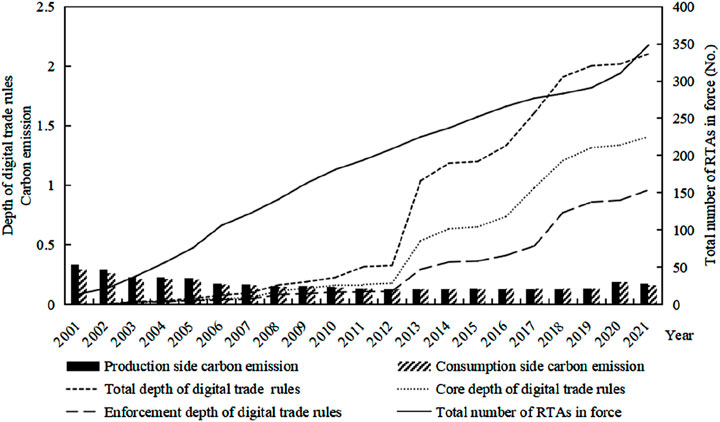
Figure 3. Trend of changes in the carbon emission, number of RTAs and the depth of digital trade rules from 2001 to 2021.
5.2 Benchmark regression
The Poisson Pseudo Maximum Likelihood (PPML) method is a regression-based technique used to estimate the model parameters of counting data. It is particularly well-suited for situations involving overly discrete or zero-inflated data. The fundamental approach involves maximising the pseudo-likelihood function according to the given independent variables and parameters under the Poisson assumption. The PPML method is particularly effective in producing accurate estimation results when confronted with a high number of zero values, regression model errors or heteroscedasticity in the sample. Correia et al. (2020), we employ the PPML method to conduct the regression, presenting the baseline regression results in Table 2.
As illustrated in Table 2, the deepening of digital trade rules can significantly reduce the intensity of implied carbon emissions from exports at both the production and consumption sides; the effect on implied carbon emissions at the production side is greater than at the consumption side. Further analysis of the impact of the three rule depths on export carbon emissions indicates that the inhibitory effect of digital trade rules on export carbon emissions is characterised by the following order of magnitude: enforcement depth > core depth > total depth. This indicates that, although the overall depth of the framework is extensive, the generalised provisions result in the dispersion of compliance costs for enterprises and insufficient actual motivation for emission reduction. When the core focuses on key areas to directly reduce carbon emission intensity but lacks implementation guarantees, enterprises can circumvent constraints through “selective compliance”. The depth of execution, through real-time supervision and punitive mechanisms, significantly increases the cost of violations, forcing enterprises to internalise low-carbon technologies as core variables in production decisions.
The coefficients of the control variables are all in line with expectations. The coefficients of economic development, industrial size, geographical distance, difference in environmental regulation and industry energy structure are all found to be significant. This indicates that as a country’s economy develops more rapidly, its industrial base grows larger and it becomes more geographically distant from other countries. Additionally, the difference in environmental regulation between importing and exporting countries results in increased trade-related carbon emissions. The coefficients relating to the presence of a common language or a colonial relationship between the two countries are notably negative, suggesting that nations tend to seek culturally similar partners for international trade. These economies often exhibit greater similarity in trade policies, regulations, consumer demand, market structure and other factors, facilitating technical cooperation and technology transfer between the countries, thereby reducing trade-related carbon emissions.
5.3 Endogeneity test
Despite considering a range of control variables, the study may still face endogeneity problems, the most significant of which is reverse causality. This implies that export-embodied carbon emissions may subsequently affect the depth of digital trade rules. This is because countries with lower export carbon emissions tend to sign regional trade agreements that cover more comprehensive digital trade terms, neglecting variables that could also introduce endogeneity problems. To address the above concerns regarding endogeneity, we adopt time-varying variable lag and instrumental variable (IV) methods for regression.
5.3.1 Time-varying variable lag
In light of the potential for endogeneity issues to emerge between time-varying control variables and export-embodied carbon emissions, this study employs a one-period lag strategy for all time-varying variables, as illustrated in columns (1) and (2) of Table 3. This methodological approach is employed to ensure the integrity and reliability of the regression results. The results indicate that the coefficients of digital trade rules remain significantly negative after interacting the core explanatory variable and all time-varying variables with a one phase lag, suggesting that RTA digital trade rules continue to reduce export-embodied carbon emissions.
5.3.2 Instrumental variables
This study introduces two IVs and employs two-stage least squares regression. First, we take the depth of digital trade rules with a one period lag as the first IV (DP1). The depth of digital trade rules in the historical period is an important foundation for the development of that in the current period that has no direct impact on the current export-embodied carbon emissions between countries, which satisfies the correlation and exclusivity hypotheses. Second, this study takes the average sum of the depth of digital trade rules between a country and all third countries in the sample as an IV (DP2), where a larger value indicates that country i is more likely to sign terms containing digital trade rules with countries other than country j. Therefore, it is closely related to digital rules between countries i and j, satisfying the correlation hypothesis. This IV also portrays the relevant circumstances of RTA digital rules between country i and a third country and will not directly affect the export-embodied carbon emissions between country i and country j, which satisfies the exclusivity hypothesis. Columns (3)–(6) of Table 3 present the IV regression results, revealing that the estimation results of LM statistic and Cragg-Donald Wald F statistics reject the hypotheses of IV under-identification and weak identification, confirming the reasonableness of our IV selection. Furthermore, the coefficients of digital trade rules are significantly negative, demonstrating that the conclusions remain valid.
5.4 Robustness tests
This study employs five robustness tests, replacing variables, alternative estimation methods, shrinking, truncation and replacing regression samples and DID methods.
5.4.1 Replacing core explanatory variable
In order to avoid any potential influence on our estimation results arising from differing measurement methods for core explanatory variables, we employ principal component analysis to re-weight the categorical clauses of digital rules and recalculate depth, as referenced in Laget et al. (2020). The regression results are presented in columns (1) and (2) of Table 4. The results indicate that the estimated coefficients of digital trade rules are all significantly negative, which aligns with the benchmark regression results, albeit with slightly lower estimated coefficient values.
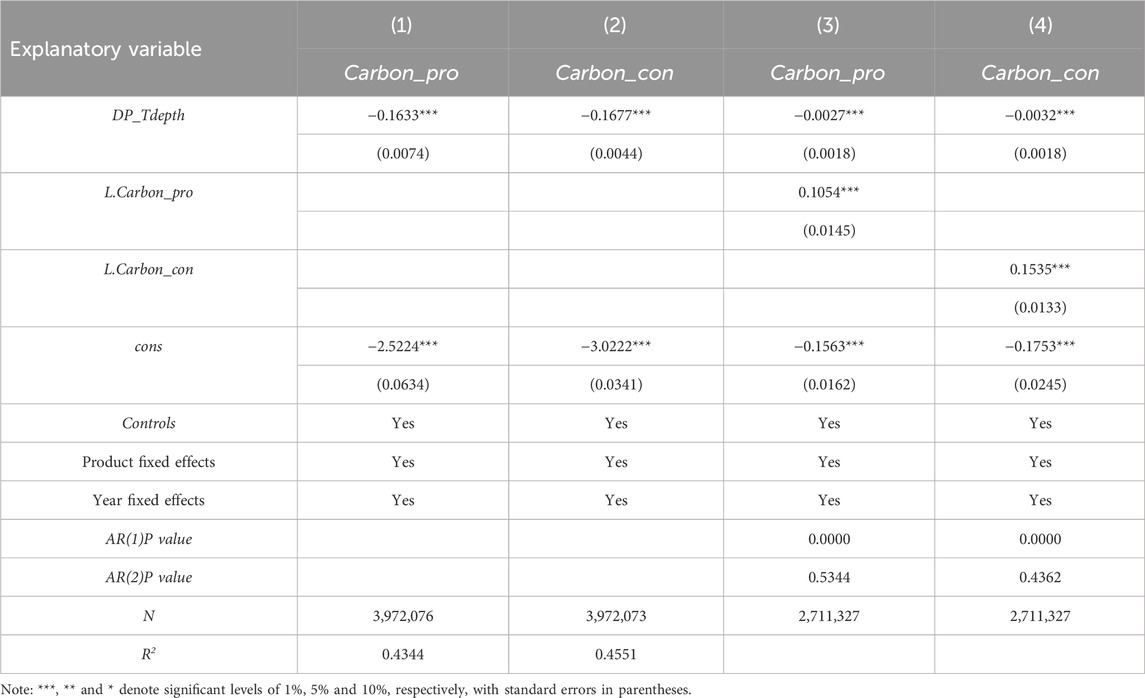
Table 4. Replacement of core explanatory variables and estimation using system GMM (Robustness test).
5.4.2 Alternative estimation methods
In order to avoid the influence of different empirical estimation methods on the conclusions obtained, we use the Generalized Method of Moments (GMM). The regression results are presented in Table 4, columns (3) and (4). Regardless of whether we use PPML or GMM, the coefficients of RTAs’ digital rules are still significantly negative, indicating that the research conclusions are robust.
5.4.3 Tail reduction and truncation
The distribution of export-related carbon emissions may be subject to bias. As extreme samples may interfere with our estimation results, we conducted 1% and 5% shrinking treatment and 1% and 5% truncation treatment on the explained variables, presenting the regression results in columns (1)–(4) of Tables 5, 6. The findings indicate that the coefficients of core explanatory variables remain substantially negative after the exclusion of outliers.
5.4.4 Changing the regression sample
Due to the time lag in implementing digital trade rules and the response of export carbon emissions to these rules, the sample interval has been divided into 3-, 4- and 5-year lags, respectively. The regression results are presented in columns (1)–(6) of Table 7. The results demonstrate that the coefficients of digital trade rules are significantly negative, confirming that the revised sample intervals do not change the results and the conclusions remain valid after considering the time lag effect of digital trade rules.
5.4.5 Changing the regression method
Given the differences in the intensity and signing time of digital trade rules in RTA, this paper adopts the staggered difference-in-differences model to evaluate the policy effect of digital trade rules on export carbon emissions. Specifically, the question of whether digital trade provisions are included in RTAs is regarded as a quasi-natural experiment. The countries that signed the RTA containing the digital trade clause were designated as the treatment group, and those that did not sign were set as the control group. Regression analysis was conducted with the effective year of the policy as the time dividing point. The model construction is as Equation 8:
Where
5.5 Heterogeneity tests
5.5.1 Heterogeneity test of clause
The study categorises digital trade rules into the following headings: data management (DM), trade promotion (TF), privacy protection (PP), IP protection (IPP), network governance and security (CGS) and dispute settlement and cooperation (DRC). We are pleased to inform you that the same method as benchmark regression is used to construct the empirical examination of heterogeneous clauses. This is in order to analyse the various impacts of different digital trade rule clauses on export-related carbon emissions. Tables 9, 10 present the estimation results.
The results indicate that trade promotion clauses have the strongest inhibitory effect on export carbon emissions, followed by DM clauses. IP clauses have the weakest effect. The potential rationale for this is that trade promotion clauses primarily promote trade openness between the two sides by improving the business environment for e-commerce trade, advancing shared green technology and decreasing export-embodied carbon emissions. DM clauses provide measures for facilitating cross-border data flow, reducing trade costs for both sides and directly decreasing export-related carbon emissions. The restraining effect of IP clauses is closely associated with the intensity of protection. A minimal level of IP protection can lead to a lack of robust safeguards for enterprises’ innovation outcomes, thereby hindering the pace of technological innovation and impeding the cross-border transmission of technological innovation (Guellec and Paunov, 2018). Conversely, an overly stringent IP protection policy may impede competition and innovation, thereby diminishing the knowledge and technology spillover effect. When the above clause types are compared, the effect of IP protection clauses on export carbon emissions reduction is relatively low.
5.5.2 Heterogeneity test of RTA template
As previously outlined, the two primary templates of RTA digital trade rules are the American and European templates, which reflect variations in the fundamental requirements and core provisions. The impact of digital trade rules under various agreement templates on export-related carbon emissions may exhibit heterogeneity. This study uses RTA samples similar to the existing rules templates in TAPED to conduct regressions based on the heterogeneity of template types. The regression results are presented in columns (1) to (6) of Table 11.
The results indicate that, irrespective of execution under the European, American or other template, the coefficients of digital trade rules are significantly negative, demonstrating that digital trade rules included in different template types have an inhibitory impact on export-embodied carbon emissions. The European template is characterised by “audio-visual exception” and “privacy protection”, and it has been demonstrated to decrease export-embodied carbon emissions through privacy protection, IP protection and other provisions. The American template advocates the elimination of localised data storage and the reduction effect on export-embodied carbon emissions occurs by reducing information search costs in export trade through clauses such as “free cross-border flow of data”. From the perspective of coefficient size, compared with the American template and other templates, the coefficient of digital trade rules under the European template is relatively small. One possible explanation for this finding is that digital rules in accordance with the European model are more aligned with the current trade development stage of most economies. As these economies are more mature, they have achieved relatively low export-embodied carbon emissions reductions. In contrast, American and other templates are in the emerging stage of development, and the associated export-embodied carbon emissions reduction effects continue to strengthen.
5.5.3 Heterogeneity test of exporting country
In order to further analyse the heterogeneous impacts of RTA digital trade rules on export-embodied carbon emissions, this study separates exporting countries into developed and developing countries based on the World Bank’s 2011 income classification standard. This is the intermediate year of the time span covered in the sample. According to the standard classification, developed countries are defined as high-income nations, while middle-high- and middle-low-income countries are designated as developing nations. Developed countries are denoted as 1 and developing countries as 0. The regression results are presented in columns (1) and (2) of Table 12.
The results demonstrate that the coefficients of DP_Tdepth and DP_Tdepth*country in columns (1) and (2) are all significant. Digital trade rules have a beneficial effect on export-embodied carbon emissions for developed countries. One potential explanation for this phenomenon is that developing economies have a relatively low level of trade liberalisation, and the implementation of digital trade rules does not significantly enhance trade openness. Consequently, there has been an observed rise in export-related carbon emissions, as enterprises in developing nations have not adapted to the added costs associated with digital trade rules. Concurrently, the low-carbon energy transition is leading to a decline in oil revenue and non-revenue for African nations (Emmanuel et al., 2024), resulting in mounting economic pressures that could potentially impede their ability to invest in green technologies or adhere to environmental regulations. However, developed economies have high trade openness, and digital trade rules have produced considerable technology spillover effects, establishing new opportunities to reduce export-embodied carbon emissions through innovation, diffusion and sustainable supply chain integration.
5.5.4 Heterogeneity test of agreement type
Based on the number of RTA members, this study divides trade agreements into bilateral and regional RTAs for comparative analysis. Among the 191 agreements in the sample economies, 115 are bilateral RTAs between two economies and 76 are regional RTAs that include more than two economies. This study is based on different types of digital trade rules. It further regresses bilateral agreements and multilateral agreements, marking bilateral agreements as 1 and multilateral agreements as 0. The regression results are shown in columns (3) to (4) of Table 12.
The findings indicate that the coefficients of DP_Tdepth and DP_Tdepth*agreement exhibit a strong negative correlation in columns (3) and (4), suggesting that different types of RTA digital agreements can reduce export-embodied carbon emissions. Digital trade rules in bilateral agreements is higher than that of multilateral agreements. One possible explanation for this is that regional multilateral FTAs are challenging to coordinate due to the diverse interests and trade levels of the involved countries. In addition, the negotiating power of each country is limited, which makes it difficult to reach high-level digital provisions. The high cost of adapting different trade rules across overlapping multilateral RTAs means that these countries are unable to maximise the benefits of digital trade rules.
5.5.5 Heterogeneity test of product type
The Pollution Paradise Hypothesis suggests that developed countries with strict environmental regulations are likely to transfer pollution-intensive manufacturing operations to developing countries with weaker regulations. Additionally, there may be variations in the response of products with different levels of pollution. In order to analyse the different impacts of digital trade rules on carbon emissions related to the export of environmentally friendly products, this study classified export products into green products and non-green products based on pollution differences, with green products marked as 1 and non-green products as 0. The results are shown in Table 12.
The results reveal that the coefficients of DP_Tdepth and DP_Tdepth*green in columns (5) and (6) are all significantly negative, demonstrating that digital trade rules can decrease carbon emissions for different types of environmental protection products. Digital trade rules have further reduced carbon emissions from the export of green products. One possible explanation for this could be that green products emit significantly less carbon than non-green products; therefore, the marginal benefit of digital trade rules is not substantial. Recently, countries have become increasingly concerned with the environmental protection and pollution reduction of non-green products. They have been continuously upgrading the reduction technology of export-embodied carbon emissions and achieving remarkable results.
6 Mechanism study
6.1 Model setting
The results of the benchmark regression clearly indicate that RTA digital trade rules can contribute to a reduction in export-embodied carbon emissions. Our theoretical analysis indicates that trade cost, technological innovation, regulatory distance and value chain correlation are key mechanisms through which RTA digital trade rules impact export-embodied carbon emissions. Jiang (2022), this study conducts a mechanism test to examine mediating effects, and the model is as Equations 9–12:
Where
6.2 Variable description
Technological innovation effect (
Trade cost effect (
Regulatory distance effect (
Value chain correlation effect (
6.3 Mechanism result
The results in column (1) of Table 135 show that the coefficient of digital trade rules is positive, indicating that digital trade rules stimulate exporting countries’ technological innovation. RTAs are conducive to the use and sharing of green technologies between the contracting parties, enabling countries to efficiently adopt advanced technologies through knowledge and technology spillovers. The results in column (2) of Table 13 reveal that the coefficient of digital trade rules is negative, indicating that digital trade rules reduce trade costs between importing and exporting countries. RTAs’ digital trade rules contain provisions such as cross-border data flow that can reduce restrictions on market access and trade costs. In addition, RTAs’ digital trade rules also enable governments to fully release the power of data as a production input factor, improving enterprises’ efficiency, which is also conducive to reducing enterprise costs. The results in column (3) of Table 13 show that the coefficient of digital trade rules is negative, indicating that digital trade rules shorten the regulatory distance between the two contracting countries. RTAs provide standardised trade rules and frameworks for contracting parties, resulting in different degrees of regulatory convergence among governments. This also puts pressure on the contracting parties to establish clearer rules and regulations, which helps to reduce the differences in contracting parties’ regimes. The results in column (4) of Table 13 reveal that the coefficient of digital trade rules is positive, indicating that digital trade rules strengthen the value chain correlation between exporting and importing countries. First, RTAs lower information transfer costs, which reduces the trade cost of intermediate goods needed by countries, deepening the correlation of bilateral value chains. Second, RTAs facilitates small and medium-sized enterprises’ embedding in value chains by simplifying the transaction process. Tables 14, 15 present the endogeneity test results of the mechanism test. The results of the mechanism test are robust.
7 Discussion
This study reveals the significant role of digital trade rules in reducing the carbon emission intensity implied by exports. Our findings demonstrate that the deepening of digital trade rules has led to a substantial reduction in carbon emission intensity at the production stage, with a more pronounced impact compared to the consumption stage. This result aligns with existing literature emphasising the dual economic and environmental benefits of digitalization, yet diverges from conventional carbon emission analyses by highlighting a novel pathway: digital trade rules exert influence through reducing cross-border transaction frictions and optimising resource allocation. This mechanism offers a novel theoretical lens for understanding the digital-environment nexus.
Mechanism analysis has identified technological innovation, cost reduction, shortened regulatory distance, and bilateral value chain inter-connectedness as the key pathways linking digital trade rules to carbon emissions. These findings are in line with scholarly arguments that technological progress and supply chain optimisation act as environmental catalysts. For instance, previous studies have indicated that technological innovation can enhance production efficiency and promote environmental quality through energy conservation (Lashka et al., 2012; Bieser and Hilty, 2018). Our research corroborates this mechanism and strengthens it with quantitative evidence, delineating the specific channels through which digital rules operate.
Heterogeneity analysis reveals marked disparities in the carbon-mitigating effects of distinct trade provisions. Notably, trade promotion clauses have the strongest inhibitory effect on carbon emissions, likely attributable to their direct role in reducing trade barriers and accelerating transaction processes. In contrast, provisions for the protection of intellectual property demonstrate relatively limited impact, possibly because such clauses prioritise the commercialisation of innovation outcomes rather than directly addressing carbon emissions. These findings emphasise the importance of provision-specific analysis in evaluating the environmental efficacy of digital trade rules.
A comparative analysis with existing studies highlights two key contributions: Firstly, our research extends the current understanding of the environmental impact of digital trade by emphasising the role of green trade policies and international cooperation frameworks. Secondly, it demonstrates that digital trade rules hold particular promise for global carbon reduction when embedded in bilateral agreements and green product provisions. Collectively, these insights advance understanding of how institutional design in digital trade can be harnessed to reconcile economic globalisation with climate goals.
8 Conclusion
8.1 Conclusions
Improving the depth of RTA digital trade rules, promoting international trade liberalisation, effectively reducing export-embodied carbon emissions and establishing a green and low-carbon global society are key approaches for advancing the global economy’s sustainable development in the coming years. Using regional trade agreements (RTA) and bilateral trade data signed and implemented by 137 economies from 2001 to 2021, this paper quantifies the depth of digital trade rules from three aspects: total depth, core depth and enforceability depth, based on the classification of digital trade rules in the TAPED database. Subsequently, by using the extended structural gravity model and adopting the PPML estimation method, the influence effect and mechanism of digital trade rules on the export embodied carbon intensity at the production and consumption sides in RTA were explored.
The study finds that: (1) The deepening of digital trade rules can significantly reduce the intensity of implied carbon emissions from exports at both the production and consumption sides; the effect on implied carbon emissions at the consumption side is greater than at the production side. (2) Mechanism analysis shows that the effects of technological innovation, cost reduction, shortening regulatory distances and bilateral value chain correlation are important mechanisms in the impact of digital trade rules on export-embodied carbon emission intensity. (3) Heterogeneity analysis shows that trade promotion provisions have the strongest effect on export-related carbon emissions, followed by data management provisions. Intellectual property protection provisions have the weakest effect. Bilateral agreements, US templates, exports to developed countries and green products in digital trade rules have a greater inhibitory effect on carbon emissions.
8.2 Policy implication
Given the above conclusions, we propose the following recommendations. Firstly, in order to further leverage the emission reduction effects of digital trade rules on export-embodied carbon, it is recommended that priority be given to the deepening of production-side digital clause design in multilateral and bilateral trade agreements. For instance, RTAs have the potential to incorporate mandatory carbon footprint data sharing clauses, which would require enterprises to disclose production-stage emissions in real-time through blockchain technology. This could be supported by tax incentives to encourage the adoption of low-carbon digital technologies, such as intelligent energy management systems. On the consumption side, efforts could be concentrated on the establishment of cross-border carbon label mutual recognition mechanisms, the utilisation of digital platforms for the display of product life-cycle carbon intensity to consumers, and the harnessing of market demand to drive production-side emission reductions.
Secondly, it is proposed that a “cross-border digital regulatory coordination clause” be incorporated into the digital trade agreement. The establishment of a blockchain-driven regulatory data sharing platform has the potential to facilitate real-time mutual recognition and dynamic adjustment of carbon emission standards among import and export countries. This, in turn, could lead to a reduction in the repetitive declaration and compliance costs incurred by enterprises as a result of regulatory differences. At the same time, efforts must be made to encourage the creation of a unified low-carbon digital trade regulation framework, with the aim of reducing carbon emission intensity across the entire supply chain at the institutional level.
Thirdly, it is suggested that the digital trade rules be optimised at different levels. The primary focus of the commission will be on the enhancement of trade promotion provisions, including mutual recognition of electronic signatures and seals, and the implementation of zero tariffs on digital products. Concurrently, efforts will be undertaken to refine data management provisions, provide clear definitions of standards for cross-border flow of green data and blockchain evidence storage, and establish intellectual property protection in relation to low-carbon technologies. For instance, a “green channel” has been implemented for the accelerated review of energy-saving technology patents related to digital trade, and enterprises are permitted to exchange patent sharing for carbon quota discounts, thereby indirectly promoting emission reduction across the entire industry through technology diffusion.
8.3 Future direction
The present study explores the export carbon reduction effect of digital trade rules. In future research, the role of digital trade rules in trade fairness, digital sovereignty and geopolitical conflicts can be analysed in depth, with particular attention to the path of building the discourse power of developing countries in rule-making. Concurrently, the coordination mechanism between digital trade and cross-border carbon emission regulation should be explored, and the discussion should address how to promote the consistency of global carbon emission regulation through international cooperation and institutional design, and reduce the friction in the implementation process of digital trade rules in different regions.
Data availability statement
The data analyzed in this study is subject to the following licenses/restrictions: The datasets used for current study are available from the corresponding authors on request. Requests to access these datasets should be directed to bHN1anVhbnN1ZUAxMjYuY29t.
Author contributions
SL: Methodology, Software, Writing – original draft, Writing – review and editing. YG: Methodology, Data analysis, Writing – review and editing.
Funding
The author(s) declare that no financial support was received for the research and/or publication of this article.
Conflict of interest
The authors declare that the research was conducted in the absence of any commercial or financial relationships that could be construed as a potential conflict of interest.
Generative AI statement
The author(s) declare that no Generative AI was used in the creation of this manuscript.
Any alternative text (alt text) provided alongside figures in this article has been generated by Frontiers with the support of artificial intelligence and reasonable efforts have been made to ensure accuracy, including review by the authors wherever possible. If you identify any issues, please contact us.
Publisher’s note
All claims expressed in this article are solely those of the authors and do not necessarily represent those of their affiliated organizations, or those of the publisher, the editors and the reviewers. Any product that may be evaluated in this article, or claim that may be made by its manufacturer, is not guaranteed or endorsed by the publisher.
Footnotes
1Source: United Nations conference on trade and development database (UNCTAD STAT), https://unctadstat.unctad.org/EN/
2Source: World Trade Report 2022, Chapter F: “Digital Trade and Regional Integration”.
3Data source: The World Trade Report2018, https://www.wto.org/english/res_e/publication_e/word_trade_report18_e_under_embargo.pdf
4The Proposal of the Central Committee of the Communist Party of China on Formulating the 14th Five-Year Plan for National Economic and Social Development and Long-Range Objectives Through the Year 2035, https://www.gov.cn/zhengce/202203/content_3635465.htm
5Tables 14, 15 present the endogeneity test results of the mechanism test.
References
An, Q. (2024). Empirical analysis of trade costs and their impact on carbon emissions in RCEP countries [J]. J. Environ. Manage. 365 121666. Available online at: https://xueshu.baidu.com/usercenter/paper/show?paperid=1v2y0gb07m2r0cg0du4y08g0jx217454&site=xueshu_se.
Anderson, D. (2001). Technical progress and pollution abatement: an economic view of selected technologies and practices. Environ. Dev. Econ. 6 (3), 283–311. doi:10.1017/s1355770x01000171
Anderson, J. E., and Wincoop, A. E. V. (2003). Gravity with gravitas: a solution to the border puzzle. Am. Econ. Rev. 93 (1), 170–192. doi:10.1257/000282803321455214
Antràs, P., and Helpman, E. (2004). Global sourcing. J. Political Econ. 112 (3), 552–580. doi:10.1086/383099
Bieser, J. C. T., and Hilty, L. M. (2018). “Indirect effects of the digital transformation on environmental sustainability: methodological challenges in assessing the greenhouse gas abatement potential of ICT,” in 5th International Conference on Information and Communication Technology for Sustainability. Chongqing, China.
Burri, M., and Polanco, R. (2020). Digital trade provisions in preferential trade agreements: introducing a new dataset. J. Int. Econ. Law 23 (1), 187–220. doi:10.1093/jiel/jgz044
Calantone, R., Garcia, R., and Dröge, C. (2003). The effects of environmental turbulence on new product development strategy planning. J. Prod. Innovation Manag. 20 (2), 90–103. doi:10.1111/1540-5885.2002003
Chaney, T. (2014). The network structure of international trade. Am. Econ. Rev. 104 (11), 3600–3634. doi:10.1257/aer.104.11.3600
Chen, C., and Steinwender, C. (2021). Import competition, heterogeneous preferences of managers, and productivity. J. Int. Econ. 3, 103533. doi:10.1016/j.jinteco.2021.103533
Copeland, B. R., and Taylor, M. S. (1994). North-South trade and the environment. Q. J. Econ. 109 (3), 755–787. doi:10.2307/2118421
Correia, S., Guimarães, P., and Zylkin, T. (2020). Fast poisson estimation with high-dimensional fixed effects. Stata J. 20 (1), 95–115. doi:10.1177/1536867X20909691
Cui, R. M., Guo, Z. Z., and Chen, Y. S. (2024). The impact of digital trade rules in regional trade agreements on the domestic value added of exporting countries. J. Int. Trade 5, 54–69. doi:10.13510/j.cnki.jit.2024.05.003
Das, G. G., and Andriamananjara, S. (2006). Hub-and-spokes free trade agreements in the presence of technology spillovers: an application to the Western hemisphere. Rev. World Econ. 142, 33–66. doi:10.1007/s10290-006-0056-x
Duval, Y., Utoktham, C., and Kravchenko, A. (2018). Impact of implementation of digital trade facilitation on trade costs. ARTNeT Working Paper Series.
Ekesiobi, C., Emmanuel, P. M., Mgbemena, E., Ibekilo, B., Chukwuemeka, D., and Madueme, I. (2024). Reconsidering the pollution haven hypothesis: an investigation of international trade, foreign direct investment, and carbon emission nexus in Nigeria. J. Chin. Econ. Bus. Stud. 23 (2), 233–257. doi:10.1080/14765284.2024.2435227
Elsig, M., and Klotz, S. (2021). Digital trade rules in preferential trade agreements: is there a WTO impact? Glob. Policy 12, 25–36. doi:10.1111/1758-5899.12902
Emmanuel, P. M., Ugwunna, O. T., Azodo, C. C., and Adewumi, O. D. (2024). Low-carbon energy transition in oil-dependent African countries: implication on fiscal revenue. Int. J. Energy Sect. Manag. 18 (6), 1709–1725. doi:10.1108/ijesm-08-2023-0026
Fan, H., and Hossain, M. I. (2018). Technological innovation, trade openness, CO2 emission and economic growth: comparative analysis between China and India. Int. J. Energy Econ. Policy 8 (6), 240. doi:10.32479/ijeep.7171
Fisher-vanden, K., Jefferson, G. H., Liu, H., and Tao, Q. (2004). What is driving China’s decline in energy intensity? Resour. Energy Econ. 26 (1), 77–97. doi:10.1016/j.reseneeco.2003.07.002
Grossman, G. M., and Krueger, A. B. (1995). Economic growth and the environment. Nber Work. Pap. 110 (2), 353–377. doi:10.1016/B0-12-226865-2/00084-5
Guellec, D., and Paunov, C. (2018). Innovation policies in the digital age. Paris, France: OECD Working Paper.
Haldar, A., and Sethi, N. (2022). Environmental effects of information and communication technology exploring the roles of renewable energy, innovation, trade and financial development. Renew. Sustain. Energy Rev. 153, 111754. doi:10.1016/j.rser.2021.111754
Hortaçsu, A., Martínez-jerez, F. A., and Douglas, J. (2009). The geography of trade in online transactions: evidence from eBay and Mercadolibre. Am. Econ. J. Microeconomics 1 (1), 53–74. doi:10.1257/mic.1.1.53
Janow, M. E., and Mavroidis, P. C. (2019). Digital trade, E-commerce, the WTO and regional frameworks. World Trade Rev. 18 (S1), S1–S7. doi:10.1017/s1474745618000526
Jiang, T. (2022). Mediating effects and moderating effects in causal inference. China Ind. Econ. 5, 100–120. doi:10.19581/j.cnki.ciejournal.2022.05.005
Kander, A., Jiborn, M., Moran, D., and Wiedmann, T. (2015). National green house gas accounting for effective climate policy on international trade. Nat. Clim. Change 5 (5), 431–435. doi:10.1038/nclimate2555
Kim, D. H., Suen, Y. B., and Lin, S. C. (2019). Carbon dioxide emissions and trade: evidence from disaggregate trade data. Energy Econ. 78, 13–28. doi:10.1016/j.eneco.2018.08.019
Kohl, T., and Trojanowska, S. (2015). Heterogeneous trade agreements, WTO membership and international trade: an analysis using matching econometrics. Appl. Econ. 47 (33), 3499–3509. doi:10.1080/00036846.2015.1016211
Laget, E., Osnago, A., Rocha, N., and Ruta, M. (2020). Deep trade agreements and global value chains. Rev. Industrial Organ. 57, 379–410. doi:10.1007/s11151-020-09780-0
Lashka, R., Izadeh, M., and Salatin, P. (2012). The effects of information and communications technology (ICT) on air pollution. Elixir Pollut. 46, 8058–8064. doi:10.1007/s11356-020-09704-1
Lendle, A., Olarrega, M., Schropp, S., and Vézina, P.-L. (2013). eBay’s anatomy [J]. Econ. Lett. 121 (1), 115–120. Available online at: https://xueshu.baidu.com/usercenter/paper/show?paperid=ebf0f4c917bd189ff09c1422cac5a1e8&site=xueshu_se.
Li, D., and Meng, H. Y. (2024). Has the deepening of digital trade rules brought environmental benefits: an analysis based on the perspective of embodied carbon emissions in trade. Int. Econ. Trade Res. 40 (2), 39–57. doi:10.13687/j.cnki.gjjmts.20240015.001
Li, K., and Qi, S. Z. (2011). Trade openness, economic growth and carbon dioxide emission in China. Econ. Res. J. 46 (11), 60–72+102. doi:10.13687/j.cnki.gjjmts.20240015.001
Liu, Q., and Ma, H. (2020). Trade policy uncertainty and innovation: firm level evidence from China’s WTO accession. J. Int. Econ. 127, 103387. doi:10.1016/j.jinteco.2020.103387
Liu, B., Zhen, Y., and Li, X. F. (2021). The impact of regulatory convergence on digital trade: a test based on WIOD digital content industry. World Econ. 44 (7), 3–28. doi:10.19985/j.cnki.cassjwe.2021.07.002
Liu, H., Zhang, C. C., and Zhu, W. L. (2024). Analysis of the pollution and carbon reduction effects of digital trade. Int. Bus. 2, 61–80. doi:10.13509/j.cnki.ib.2024.02.007
Long, C., and Zhang, X. (2011). Cluster-based industrialization in China: financing and performance. J. Int. Econ. 84 (1), 112–123. doi:10.1016/j.jinteco.2011.03.002
Los, B., Timmer, M. P., and De Vries, G. J. (2014). How global are global value chains? A new approach to measure international fragmentation. J. Regional Sci. 55 (1), 66–92. doi:10.1111/jors.12121
Ma, T., and Wang, Y. (2021). Globalization and environment: effects of international trade on emission intensity reduction of pollutants causing global and local concerns. J. Environ. Manag. 297, 113249. doi:10.1016/j.jenvman.2021.113249
Ma, S. Z., Fang, C., and Liang, Y. F. (2019). Digital trade: definition, practical significance and research prospects. J. Int. Trade 2, 176–187. doi:10.13510/j.cnki.jit.2019.02.013
Mattoo, A., Mulabdic, A., and Ruta, M. (2022). Trade creation and trade diversion in deep agreements. Can. J. Econ. 55 (3), 1598–1637. doi:10.1111/caje.12611
Meng, B., Peters, G. P., Wang, Z., and Li, M. (2018). Tracing CO2 emissions in global value chains. Energy Econ. 73, 24–42. doi:10.1016/j.eneco.2018.05.013
Mesagan, E. P., Akinsola, F., Akinsola, M., and Emmanuel, P. M. (2022). Pollution control in Africa: the interplay between financial integration and industrialization. Environ. Sci. Pollut. Res. 29, 29938–29948. doi:10.1007/s11356-021-18489-w
Moore, E. M., Dau, L. A., and Mingo, S. (2021). The effects of trade integration on formal and informal entrepreneurship: the moderating role of economic development. J. Int. Bus. Stud. 52, 746–772. doi:10.1057/s41267-020-00386-y
Oh, W., and Park, E. G. (2016). Adoption of digital repositories for CO2 emissions reduction: the case of Korea. Appl. Econ. 48 (40), 3812–3825. doi:10.1080/00036846.2016.1145351
Peng, Y., and Yang, B. Z. (2023). Third-country trade effects of digital rrade rules in regional rrade agreements: diversion or spillover. J. Int. Trade 1, 36–54. Available online at: https://kns.cnki.net/kcms2/article/abstract?v=LAxyzr1RAmrkmzCXhngOI4qC_NgBD1uS1m3hIUm_iSG2lAy0CbGe5LTCGa3Bt8j0qhGB_pt8NZxirGuy6ETjSSbzv2CsWN7q_7ZOaG4JGofiWSe9DiC3JCx2wIqLOUQqMBMrhl93r5d2-nUqWNwBaD0L3mwXuQ7wpcVV-IlNr_EyqpPbu31N7Q==&uniplatform=NZKPT&language=CHS, doi:10.13510/j.cnki.jit.2023.01.009
Qi, J. Y., and Ren, Y. D. (2021). The impact of digital economy penetration on global value chain position—transnational empirical research based on industrial heterogeneity. J. Int. Trade 9, 105–121. doi:10.13510/j.cnki.jit.2021.09.007
Qi, J. Y., Li, Y. H., and Qiang, H. J. (2023). Whether concluding RTA digital trade rules can promotethe digital development of domestic industry. Int. Econ. And Trade Res. 39 (8), 40–56. doi:10.13687/j.cnki.gjjmts.20230821.003
Steinwender, C. (2018). Real effects of information frictions: when the states and the kingdom became united. Am. Econ. Rev. 108 (3), 657–696. doi:10.1257/aer.20150681
Sun, C., Ma, T. M., Ouyang, X. L., and Wang, R. (2021). Does service trade globalization promote trade and low-carbon globalization? Evidence from 30 countries. Emerg. Mark. Finance Trade 57 (5), 1455–1473. doi:10.1080/1540496x.2019.1627517
Sun, Y. H., Yu, M. Y., and Shang, Y. (2022). The impact of RTA digital trade rules on services trade exports: evidence from APEC members. Nankai Econ. Stud. 3, 142–160. doi:10.14116/j.nkes.2022.03.008
Valarezo, Á., Pérez-amaral, T., Garín-muñoz, T., Herguera García, I., and López, R. (2018). Drivers and barriers to cross-border E-commerce: evidence from Spanish individual behavior. Telecommun. Policy 42 (6), 464–473. doi:10.1016/j.telpol.2018.03.006
Vogel, D. (1995). Trading up: consumer and environmental regulation in a global economy. Cambridge: Harvard University Press.
Wen, H., Chen, W., and Zhou, F. (2023). Does digital service trade boost technological innovation? International evidence. Socio-economic Plan. Sci. 88, 101647. doi:10.1016/j.seps.2023.101647
Wilson, J. S., Mann, C. L., and Otsuki, T. (2005). Assessing the benefits of trade facilitation: a global perspective. World Econ. 28 (6), 841–871. doi:10.1111/j.1467-9701.2005.00709.x
Yuan, L., and Zou, Z. S. (2018). Heterogeneity of enterprises, export decisions, and employment effects: a discussion on the response to the China US trade war. Econ. Perspect. 9, 67–83.
Zhang, J. (2020). International production fragmentation, trade in intermediate goods and environment. Econ. Model. 87, 1–7. doi:10.1016/j.econmod.2019.06.015
Zhao, J. Y., He, S. Q., and Zhang, R. Q. (2022). Research on the impact of RTA digital trade rules on value-added trade in digital industry. World Econ. Stud. 9, 48–61+136. doi:10.13516/j.cnki.wes.2022.09.006
Keywords: regional trade agreements, digital trade rules, export-embodied carbon emissions, MRIO model, mechanism study
Citation: Liu S and Gao Y (2025) The impact of digital trade rules on the export-embodied carbon emissions. Front. Environ. Sci. 13:1640064. doi: 10.3389/fenvs.2025.1640064
Received: 03 June 2025; Accepted: 14 August 2025;
Published: 20 November 2025.
Edited by:
Mohammad Haseeb, Wuhan University, ChinaReviewed by:
Zain Ul Abidin Syed, Wuhan University, ChinaPrecious Muhammed Emmanuel, University of Ibadan, Nigeria
Copyright © 2025 Liu and Gao. This is an open-access article distributed under the terms of the Creative Commons Attribution License (CC BY). The use, distribution or reproduction in other forums is permitted, provided the original author(s) and the copyright owner(s) are credited and that the original publication in this journal is cited, in accordance with accepted academic practice. No use, distribution or reproduction is permitted which does not comply with these terms.
*Correspondence: Sujuan Liu, bHN1anVhbnN1ZUAxMjYuY29t
 Sujuan Liu
Sujuan Liu Yiyao Gao2
Yiyao Gao2